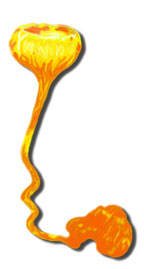How to submit a specimen to CUP
CUP does not provide routine identification services. If you have a sick plant or a curious fungus, please consult the web site of our Plant Disease Diagnostic Clinic.
Most CUP specimens are stored as dried material in paper packets or small boxes. When preparing specimens, keep our standard packet dimensions in mind and cut substrates to fit, where possible. We discourage gluing specimens into packets or boxes, as this can make observation difficult. Instead, enclose small or fragile materials in a waxed paper envelope or small box. Notes and annotation slips should be included in packets; photographs may also be included or stored separately in our photograph collection. Microscope slides may be included in packets if placed in a cardboard or plastic holder. Spore prints may also be included on a folded piece of paper.
Keep in mind that your specimen needs to last for hundreds of years. Avoid the use of nonarchival materials for annotation slips, notes, and packing materials, and be sure to use pencil or archival-quality black ink.
We can accept only dried, prepared materials for accession. We encourage you to deposit cultures derived from your specimens in an appropriate culture collection, such as ATCC, ARSEF, or CBS. We recommend that you contact the staff before sending material. Unidentified, poorly prepared, or insect-infested materials may be rejected.
CUP Standard packet sizes
Package your specimens in a temporary but secure manner for mailing; we will packet your specimens upon receipt. When preparing your material, please keep in mind our standard packet sizes:
- Small packet: 14 x 9 cm
- Small packet boxes: (13.5 x 7 x 2.5 cm) or (13.5 x 9.5 x 4.5 cm) or (12 x 9.5 x 6.5 cm)
- Large packet: 19 x 13 cm
- Large packet boxes: (18 x 12.5 x 4 cm) or (18 x 12.5 x 7 cm)
Please consult the curator for advice on unwieldy materials.
Accession information
The following information must accompany your specimen:
- Name of the fungus, including authorities
- Collection location (including Country, State, County, Town or City, and specific locality information. In addition to this data, you may provide GPS coordinates)
- Host (substrate or Latin and common names of plant/animal host)
- Date of collection
- Full names of collectors and collector's number
- Full names of determiners (person(s) who identified the fungus)
- Notes on field characters, taxonomic features, synonyms, or other data
- Accession numbers in other herbaria or culture collections, or of a molecular sequence deposited in GenBank
- Publications that refer to this specimen (please also send us a reprint)
- Complete contact information for you, the depositor
At CUP, incoming materials are routinely frozen prior to joining the collection, but please use reasonable care to avoid sending us pest-infested or moist specimens.
Pack your specimens securely in a sturdy box that is resistant to crushing during mailing. We will acknowledge receipt of the specimens and provide an accession number by e-mail. Newly accessioned specimens may not appear on our website for several months. Refer to the Home page for our mailing address.
Special cases
- Liquid preserved specimens
- Our curatorial resources do not permit us to adequately maintain specimens stored in liquid. Please contact us for suggestions on other ways to handle these materials.
- Dried cultures
-
Sporulating cultures of microfungi can be dried to yield acceptable herbarium specimens. We prefer the method outlined by Pollack (1967), and can provide a limited number of folders for you to prepare your culture.
Pollack, F.G. 1967. A simple method for preparing dried reference cultures. Mycologia 59(3): 541-544. - DNA
- If you wish to deposit DNA with your specimen, you may include it as a freeze-dried pellet stored in a microcentrifuge tube or vacuum-sealed glass ampule. Include a note that details the approximate amount of DNA and its source (specimen or culture). Note that we have no data on the long-term survival of DNA in the herbarium, and we are not able to provide refrigerated storage.
A collection of preserved plant disease and fungus specimens documenting the world's biodiversity
CUP Pages
CUP Extras
contact:
CUP-herbarium@cornell.edu


